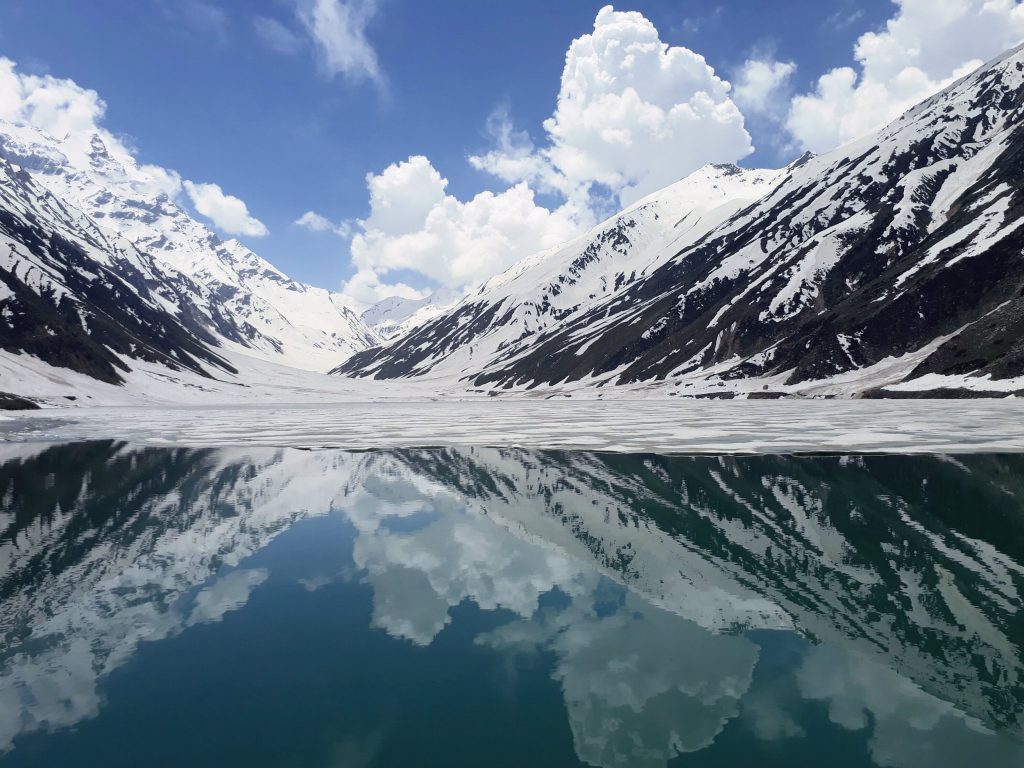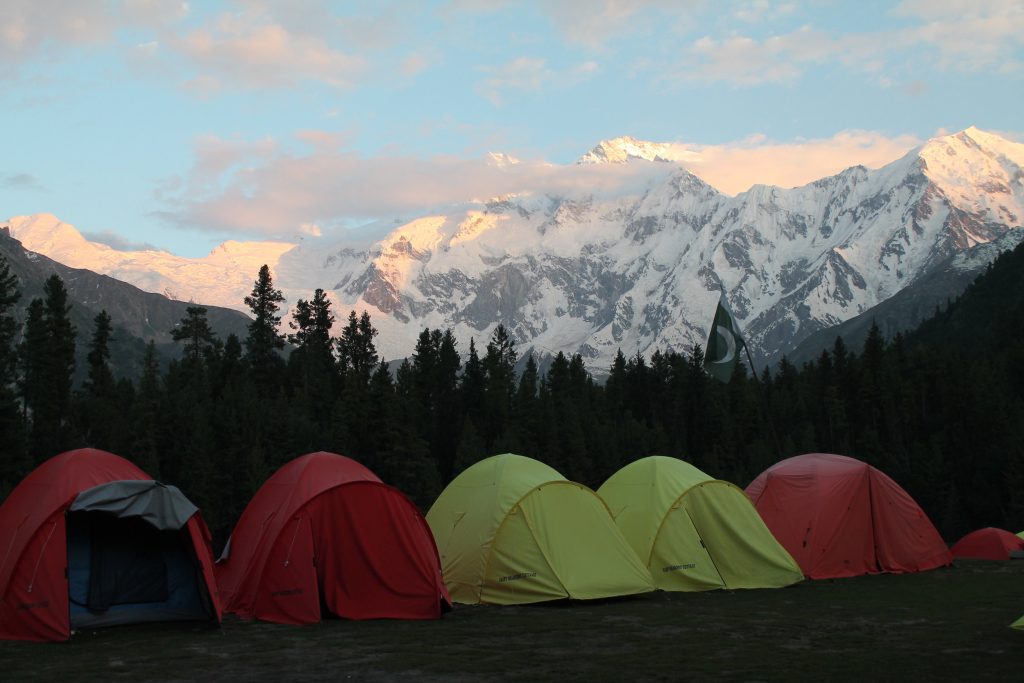Pari, Deo, and Jinn: A Look at Pakistan’s Northern Folklore
Written by Manahil Bandukwala

Around a bonfire in Fairy Meadows one night, a local, Hussain, told us that only three people have managed to summit Nanga Parbat, the ninth-tallest mountain in the world. Thousands of people have summited K2 (the second-tallest mountain), but Nanga Parbat remains a more frightening and challenging peak. No local has ever summited the mountain, because of the jinn that live there. “Foreigners have no fear of anything in their hearts,” Hussain said, so they can face the jinn along their path.

As the fire grew dimmer, Hussain shared a story about how he had taken three foreign tourists to Fairy Meadows, however they had gotten separated and lost along the way. It was dark and Hussain went back to find them. There was a certain spot marked by rocks that was said to have jinns. He decided to check there anyways, even though he was very afraid. While walking through, he felt rocks being thrown on him and heard the sound of a cat. He started feeling dizzy and fainted. Some of the other locals went looking for him, found him there, and took him back to the campsite. He became very sick and had to be taken to the hospital. He was not able to recover, and someone suggested taking him to a maulvi as he may be possessed. The maulvi cleared him from his sickness, and he eventually returned to his former self.
Folklore from the northern areas of Pakistan is full of stories of jinn, churail, and pari. Fairy Meadows was named by German mountain climbers who hiked up to the meadows and saw pari (creatures of the air) there. The locals warned and encouraged anyone with doubts to take a walk through the forest alone after sunset. The landscape lends itself to these fantastical beings. Up in the meadows, we never walked the unlit path through the forested area and always went to the bathroom in pairs. The mountainous landscape and frequent disappearances by locals make belief in the supernatural very easy for this area.
One of the most famous stories from the north is the story of Saif-ul-Malook, which shares its name with the famous lake in Kaghan Valley. The story exists in folklore and oral tradition, and was collected and written by a Punjabi Sufi poet, Mian Muhammad Bakhsh in the 19th century. The story’s original name was “Safr-ul-Ishq” (The Journey of Love).
Listen to the story of Saif-ul-Malook, as narrated by a local at Lake Saif-ul-Malook, or read Manahil’s English translation below.
The story of Saif-ul-Malook that is famous for you comes from the Prince Saif. He was the son of a king. He had a dream where he saw this place, a lake, and a pari, whose name was Badi-ud-Jamal. Before our time, before humans found this valley, this was the place of many jinn and pari. When Saif woke up, he told his father his dream. The king said, “You will find the pari, but it will be a difficult journey.” The prince left his house and was wandering for a year, but could not find any hint of the pari.
After a year, with Allah’s will, he found an elder wali (wise man) in Yusr. The elder told him of a mountain called Malka Parbat (the highest peak in the Kaghan Valley). No one has managed to summit this mountain, because jinns and paris have their stronghold there. They drop things on climbers and kill them. Helicopters and planes cannot fly over the mountain. When the prince got his information from the elder, two jinn came and transported the prince to a spot on a smaller mountain (in the Kaghan Valley) where a masjid now sits. Between the smaller mountain and Malka Parbat runs a stream, where the water’s path was different from what it is now. There was nothing between the mountains, just the lake here.
Prince Saif reached the lake and recognized it from the one in his dreams. He spent forty days in worship of Allah here. After the fortieth night, on the fourteenth night (the night of the full moon), he saw that the pari were bathing in a protected area of the lake. In that area were the pari, including the Queen of pari, Badi-ud-Jamal. The prince saw her and was happy. He sent his thanks to Allah and called the jinns to ask them how he could get the pari to him. At the lake, the pari had taken their crowns off and left them at shore. The jinns took Badi-ud-Jamal’s crown and handed it to the prince. The pari got out of the lake and picked up their own crowns, but the queen’s crown was missing. She thought her friends were playing a prank on her, but they denied doing so and flew away, leaving Badi-ud-Jamal alone.
Prince Saif approached her, and she asked him to give her crown back because if they lingered at the lake, a deo (giant) would come and capture and kill both of them. The prince did not listen to her, and look her towards Naran. At that time in Naran, there was a jungle, Biyaban. Badi-ud-Jamal prayed to Allah, and he listened to her. The pari that went back went to the deo and told him that the queen had gone missing in the lake. The deo reached the lake and searched for the queen, but could not find her. In his anger, he broke the mountain. The water flooded out, and went down to Naran where the prince and the queen were. In this way, the queen’s prayers came true. Because of the deo’s actions, the ground split and formed a cave, and the prince and the queen stayed safely in there while the flood passed from all sides. There was no light in the cave.
The deo was still searching for Badi-ud-Jamal, and in his search went up a glacier. There was a beautiful lake by the glacier, called Pyala Lake. When he set his foot there, his foot got stuck in the ground, making a crater there. There is a lake there, in which water fills from the ground. The deo searched for the queen for several days more, but still could not find her. He went to the top of a mountain and jumped from there, committing suicide. The queen’s prayers to Allah came true. Meanwhile, the queen and the prince were still in the hole. The jinns who had accompanied the prince on his journey told the pair that the deo had died. They took the prince and the queen from the cave to the lake.
This lake is now famous by the name of Saif-ul-Malook. It takes its name from the Prince Saif and the Malka (queen), and the lake they met at. The stories and folklore started. Half the water in this lake comes from the bottom, and the other half comes from the top. On the fourteenth night (the night of the full moon), the view of this lake is worth seeing. The moon, the lake, the stars, the sky. This is the night when a person can see their own reflection in the lake, as though it is a mirror. The person who spends this night in remembrance of Allah and in His worship can see the pari.

We interviewed musician Arieb Azhar, who told us how in Bukhsh’s version, Badi-ud-Jamal is imprisoned by a jinn. However, older versions, like those told in Kaghan, portray the villain as a giant. Many stories from places around the world, such as Norse lore or Greek lore, involve giants, but the villains in stories in Pakistani folklore are usually jinns. According to Arieb, Bukhsh had to turn giants into jinns to present an antagonist people would fear. People in that part of the world didn’t believe in giants, but they do believe in jinns, making them a natural villain in the story. “I sing a lot of verses from [Bukhsh’s] Saif-ul-Malook because a lot of these verses are full of folk wisdom. Destroy the mosque, destroy the temple, but never destroy the human heart because that’s where god lives. You can see that the stories coming down are actually pre-Islamic in nature, because they are full of fairies, of giants,” said Arieb.
However, northern folklore is full of giants, and remnants of that still exist in the names of places. When the giant from the story of Saif-ul-Mulook jumped from the mountain, he turned into the Deosai Plains in Skardu. In Arieb’s version, “the original giant in the Saif-ul-Malook story, he goes back once he’s lost his prisoner, he goes back to where all the giants come from and turns into a mountain, which is called deosai. Deo means giant, so deosai means land of the giants. And on the way he sheds a tear which turns into Aansoo Jheel, which is still there.” The lore around giants extends into Fairy Meadows as well. “The local name of the Nanga Parbat region is Diamer. Diamer comes from deamroo (deo) which means crouching giant. The old name of Nanga Parbat is a crouching giant. If you speak to the people around, they still believe that at night when you see the wisps of clouds, it’s actually the pari,” Arieb said.

Although pari have a strong hold in northern folklore, they are originally from Persian and Armenian folklore. “Paristan,” the land of fairies, is the mythological name for the Caucasus Mountains. Through the spread of Islam, these stories have reached South Asia, with a strong hold in the mountainous regions of the north. Their pre-Islamic appearance featured pari as mischievous spirits. Through Islamic influence, stories of pari involve them appearing as beautiful women. They help humans or may punish men in the mountains when they harm the land, and are often the target of cruel beings such as jinns and deo, as seen in the story of Saif-ul-Malook.
Through the transfer of cultures and stories, giants become jinns, and some thousand years from now, jinns will morph into something else. But some remnants of the story of Prince Saif and Badi-ud-Jamal will persist the passage of time and language.
One thought on “Pari, Deo, and Jinn: A Look at Pakistan’s Northern Folklore”
Comments are closed.